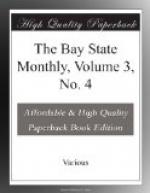The window was open. It had rained during the night, and on the soft, gravel mould beneath the window he discovered foot prints. He turned, and went to the door which communicated between the two apartments. It was unlocked. He turned the knob,—opened the door gently, and beheld John Hylton lying in a pool of blood, with his throat gashed, and with a large clasp-knife clenched in his right hand!
It was indeed a mystery. The discovery of the tragedy was followed by intense excitement. The coroner’s jury suspected Tommy Taft as the murderer, because the knife which was found in the hand of the victim bore on its hilt the initials “T.T.”, and because the tavern-keeper testified that he had heard angry words in the night.
Tommy Taft was brought to trial. It was proved that the murdered man’s money-bag was rifled of all coin, but of only one bank note,—and that, the one which the tavern-keeper had had in his possession the afternoon before the tragedy and which Tommy Taft got changed on the day after the murder. These facts, together with the footprints on the gravel soil, enabled the prosecuting attorney to make out what seemed to both judge and jury a very strong case. Indeed, there was but one person in the court room that believed the prisoner innocent,—that was Tommy Taft himself.
He admitted that he had had a dispute with his employer, but gave no cause and that the latter had peremptorily dismissed him from further service; that the bank-note was given to him that very same night, as the full amount due him; that after the dispute, he could not go to bed; that he bethought him, without disturbing anybody, to steal quietly down stairs and to depart, unobserved, by way of the front door. He sturdily denied that the footprints on the gravel soil were his. He firmly declared his innocence, and that, while he felt that he could tell the name of the murderer, he did not wish to do so, for the reason that he had no proof to support his suspicion.
Tommy Taft died on the gallows. After the execution, people gathered to discuss the event. They began to think, too, as people sometimes will when they have condemned without thinking.
“That boy’s pluckier than I’d a bin,” murmured an old man, as he dragged his weather-beaten body slowly through the crowd. “He wasn’t a guilty, Tommy Taft wasn’t.”
Nobody knew the speaker, and nobody cared for what he said.
* * * * *
THE MUSE OF HISTORY.
By Elizabeth Porter Gould.
Clio with her flickering light
And book of valued lore,
Comes down the ages dark and bright,
Our interest to implore.
She walks with glad, majestic mien,
Proud of her knowledge gained,
E’en while she mourns from having
seen
Man’s life so dulled
and pained.
Her face with lines of care is wrought,
From searching mystery’s
cause,
And dealing with the hidden thought
Of nature’s subtle laws.




